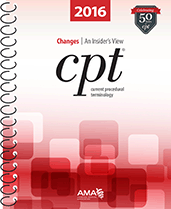 Coders, you ready for the 2016 CPT Code Changes? Every year, the AMA adds to, removes from, and revises the list of CPT codes and New Year’s Day marks the implementation of the AMA’s CPT code changes. Are you up-to-date on the latest revisions? Here’s what we know so far:
Coders, you ready for the 2016 CPT Code Changes? Every year, the AMA adds to, removes from, and revises the list of CPT codes and New Year’s Day marks the implementation of the AMA’s CPT code changes. Are you up-to-date on the latest revisions? Here’s what we know so far:
The AMA hasn’t indicated any 2016 CPT code changes for physical, occupational, or speech therapists. And there aren’t any changes affecting rehab therapy in 2016 as well, but what about other specialties?
For 2016, over 500 CPT code changes, there are 264 additions to the CPT code set, 143 deletions, 134 revisions, and some of the guidelines have been modified as well. Here is a very brief breakdown of some of the new 2016 CPT code changes:
There are 2 new add-on codes that should be used when an Evaluation/Management service is provided in the office or outpatient setting that involves prolonged clinical staff face-to-face beyond the typical time stated in the E/M code description.
+99415: Prolonged clinical staff service (the service beyond the typical service time) during an evaluation and management service in the office or outpatient setting, direct patient contact with physician supervision; first hour (list separately in addition to code for outpatient Evaluation and Management service).
+99416: Each additional 30 minutes (list separately in addition to code for prolonged service).
10035 and +10036 are new for 2016. These 2 codes are to be used for soft tissue-marker placement with imaging guidance. They are to only be used once per target, regardless of how many markers are used to mark the target.
10035: Placement of soft tissue localization device(s) (e.g. clip, metallic pellet, wire/needle, radioactive seeds), percutaneous, including imaging guidance; first lesion.
+10036: Each additional lesion (list separately in addition to code for primary procedure).
Source: For more new 2016 CPT code changes, check this article http://www.careerstep.com/blog/coding-and-billing/2016-cpt-changes
Tips for Radiology Coding – CPT Codes for Radiology

Anticipated 2016 CPT Code Changes
A number of new radiology and radiation oncology codes are anticipated for 2016. A total of 40 new codes are the result of bundling requests from the AMA’s Relativity Assessment Workgroup (RAW) for the purpose of identifying potentially misvalued services.
There were a number of radiology and radiation oncology code pairs identified as being performed together 75 percent or more of the time and, therefore, referred to the CPT Editorial Panel for bundling in 2016. The procedure codes identified as inherently performed together include: hip/pelvis radiographs, intravascular ultrasound, percutaneous genitourinary and biliary interventions, and interstitial radiation source application procedures.
In addition, a number of new codes have been created to describe procedures that are currently not described within the CPT code set, such as fetal MRI, sclerotherapy and soft tissue marker placement.
Diagnostic Radiology
Laryngography
A multispecialty society proposal requested the deletion of the laryngography code 70373, as laryngography has been replaced by endoscopy and computed tomography (CT).
Hip/Pelvis X-rays
Look for the establishment of 8 new codes to report bundled hip and pelvis radiologic exams and deletion of current codes 73500, 73510, 73520, 73530, 73540, and 73550. The existing one or two-view pelvis exam code will remain.
Codes 72170 and 73500 were identified as codes reported together greater than 75 percent of the time and, therefore, referred back to CPT for a bundled code.
CPT codes 73520 and 73550 are old codes with utilization greater than 250,000 and 500,000, respectively, that have never been valued by the Relative Value Scale Update Committee (RUC).
Fetal MRI
Two new codes to describe fetal MRI are proposed for CY2016. Currently, fetal MRI is reported with an unlisted code or with the pelvic MRI codes 72195-72197.
Percutaneous Image-Guided Sclerotherapy of Fluid Collection
Look for a new Category I code to describe percutaneous sclerotherapy of fluid collections. Currently, this procedure is described by the unlisted code or open surgical procedure codes.
Soft Tissue Marker Placement
While there are codes for marker or fiducial placement elsewhere in the body (e.g., 32553, 49411, 55876, 19081-19086, and 19281-19287), currently, there are no codes to describe soft tissue marker placement.
As placement of markers is becoming increasingly more important, two new category I CPT codes, which bundle in imaging guidance, have been requested to describe percutaneous placement of a marker for soft tissue localization.
Nuclear Medicine
Gastric Emptying With Small Bowel and Colon Transit
Two new codes to describe small-bowel and colon transit scintigraphy and revision of the gastric emptying code 78264 are proposed for 2016. This scintigraphic method allows the determination of both total and regional times for gastrointestinal transit.
Source: For more of this anticipated 2016 CPT Code Changes, check out this article from ACR Radiology Coding http://www.acr.org/Advocacy/Economics-Health-Policy/Billing-Coding/Coding-Source-List/2015/Mar-Apr-2015/CPT-2016-Anticipated-Code-Changes
Sneak Peek at 2016 CPT Cardiology Codes
What’s in Store for Abdominal Aortic Ultrasound Screening?
If you’ve been longing for a CPT code that’s specific to abdominal aortic ultrasound screening, you may be in luck in 2016. The Editorial Panel accepted the addition of a code for just this purpose. You’re likely to see it in the 767XX range.
What Will You Use for Non-Coronary IVUS?
All vascular coders should be keeping a close eye on what happens to coding for intravascular ultrasound (IVUS) coding in 2016. We may be bidding farewell to non-coronary IVUS codes +37250 and +37251 along with their RS&I codes 75945 and +75946.
Instead we may be using 3725X codes that bundle imaging services.
What’s Moving From Category III to Category I?
You may see at least two Cat. III cardiology codes make the leap to Cat. I in 2016:
- Code 0262T (Implantation of catheter-delivered prosthetic pulmonary valve, endovascular approach) may make way for a new option in the range 3347X, which includes other pulmonary valve codes.
- Another Cat. III code that may make the sought-after switch to Cat. I is 0311T (Non-invasive calculation and analysis of central arterial pressure waveforms with interpretation and report). You may be using a 9300X code in its place.
Source: http://blog.supercoder.com/coding-updates/take-a-sneak-peek-at-cpt-2016-cardiology-codes/
2016 CPT Code Changes for Pain Management Practices
CPT 2016 includes the following three new codes for pain management procedures involving paravertebral nerve blocks.
- 64461, Paravertebral block (PVB) (paraspinous block), thoracic; single injection site (includes imaging guidance, when performed)
- +64462, … second and any additional injection site(s) (includes imaging guidance, when performed) (List separately in addition to code for primary procedure)
- +64463, … continuous infusion by catheter (includes imaging guidance, when performed).
For more of this update, check out this article: Watch For New Pain Management Codes in CPT 2016
CPT Changes 2016: An Insider’s View
 For a better understanding of the CPT code set, rely on the best-selling CPT Changes 2016: An Insider’s View. Find the meaning behind all of the changes noted by the symbols you’ve come to know within the AMA’s CPT Professional Edition codebook.
For a better understanding of the CPT code set, rely on the best-selling CPT Changes 2016: An Insider’s View. Find the meaning behind all of the changes noted by the symbols you’ve come to know within the AMA’s CPT Professional Edition codebook.
Uses
Completely redesigned for ease of use and a better understanding of the changes. CPT Changes 2016 features improved rationales to communicate the reasons for, and the implications of, the changes and much more.
In 2016, many CPT code changes will take effect. This edition of CPT Changes will explain changes throughout the entire code set, including those areas with some of the most noteworthy changes: Cardiovascular, Prolonged Office Services, Digestive, Radiation Oncology, Vaccines, and Pathology/Laboratory Testing.
Features
The new 2016 edition has been completely redesigned with:
- Larger page size and spiral binding
- New headings and tabs for easier navigation
- Four-color instead of two-color printing to parallel CPT Professional
- Two-column page layout for easier reading
- Improved rationales to communicate the reasons for — and the implications of — the changes
- New table at the beginning of each section detailing the code changes within that section
- New subject-code index for quick search and access to codes and procedures
Related 2016 CPT Code Changes Posts:
- What Are CPT Codes and Why Are They Important?
- How to Look Up CPT Codes for FREE — 7 Steps!
- 2016 Medical Coding Books – New ICD-10-CM, CPT Changes, Code Set
![[CCO] Certification Coaching Organization LLC [CCO] Certification Coaching Organization LLC](https://www.cco.us/wp-content/uploads/2015/05/CCO-Logo-2015-d3-500px.png)